| Revision as of 00:38, 9 May 2016 edit187Ernest (talk | contribs)Extended confirmed users907 edits →TexasTags: Mobile edit Mobile web edit← Previous edit | Revision as of 00:43, 9 May 2016 edit undo187Ernest (talk | contribs)Extended confirmed users907 edits →TexasTags: Mobile edit Mobile web editNext edit → | ||
| Line 154: | Line 154: | ||
| ] in ]]] | ] in ]]] | ||
| {{Refimprove section|date=June 2010}} | {{Refimprove section|date=June 2010}} | ||
| In Texas, English is the state's '']'' official language (though it lacks '']'' status) and is used in government. However, the continual influx of Spanish-speaking immigrants increased the import of Spanish in Texas. Although its a part of the ], Texas's counties bordering Mexico are mostly Hispanic, and consequently, Spanish is commonly spoken in the region. The ], through Section 2054.116 of the Government Code, mandates that ] provide information on their websites in Spanish to assist residents who have limited English proficiency.<ref>"." ]. Retrieved on June 27, 2010.</ref> | In Texas, English is the state's '']'' official language (though it lacks '']'' status) and is used in government. However, the continual influx of Spanish-speaking immigrants increased the import of Spanish in Texas. Although its a part of the ],<ref name=CensusBureau/> Texas's counties bordering Mexico are mostly Hispanic, and consequently, Spanish is commonly spoken in the region. The ], through Section 2054.116 of the Government Code, mandates that ] provide information on their websites in Spanish to assist residents who have limited English proficiency.<ref>"." ]. Retrieved on June 27, 2010.</ref> | ||
| ===Puerto Rico=== | ===Puerto Rico=== | ||
Revision as of 00:43, 9 May 2016
| This article needs additional citations for verification. Please help improve this article by adding citations to reliable sources. Unsourced material may be challenged and removed. Find sources: "Spanish language in the United States" – news · newspapers · books · scholar · JSTOR (May 2015) (Learn how and when to remove this message) |
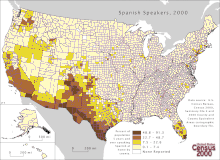
| Part of a series on |
| Hispanic and Latino Americans |
|---|
National origin groups
|
| HistoryAmericans by ancestry |
| Political movements |
| Organizations |
| Culture |
| Languages |
| Ethnic groups |
| Lists |
The Spanish language is the second most spoken language in the United States. There are 45 million Hispanophones who speak Spanish as a first or second language in the United States, as well as six million Spanish language students. Together, this makes the United States of America the second largest Hispanophone country in the world after Mexico, and with the United States having more Spanish-speakers than Colombia and Spain (but fewer first language speakers). Spanish is the Romance language and the Indo-European language with the largest number of native speakers in the world. Roughly half of all American Spanish-speakers also speak English "very well," based on their self-assessment in the U.S. Census.
There are more Spanish-speakers in the United States than there are speakers of varieties of Chinese, French, German, Italian, Hawaiian, and the Native American languages combined. According to the 2012 American Community Survey conducted by the U.S. Census Bureau, Spanish is the primary language spoken at home by 38.3 million people aged five or older, a figure more than double that of 1990.
The Spanish language has been present in what is now the United States since the 16th and 17th centuries, with the arrival of Spanish colonization in North America that would later become the states of Florida, Texas, Colorado, New Mexico, Arizona, Nevada, Utah, and California. The Spanish explorers explored areas of 42 future U.S. states leaving behind a varying range of Hispanic legacy in the North American continent. Additionally, western regions of the Louisiana Territory were under Spanish rule between 1763 and 1800, after the French and Indian War, further extending the Spanish influence throughout modern-day United States of America.
After the incorporation of these states to the United States in the first half of the 19th century, the Spanish language was later reinforced in the country by the acquisition of Puerto Rico in 1898. Later waves of emigration from Mexico, Cuba, El Salvador and elsewhere in Hispanic America to the United States beginning in the second half of the 19th century to the present-day have strengthened the role of the Spanish language in the country. Today, Hispanics are one of the fastest growing demographics in the United States, thus increasing the use and importance of American Spanish in the United States.
History

Spanish was the language spoken by the first permanent European settlers in North America. Spanish arrived in the territory of the modern United States with Ponce de León in 1513. In 1565, the Spaniards, by way of Juan Ponce de León, founded St. Augustine, Florida, and as of the early 1800s, it became the oldest continuously occupied European settlement in the continental United States. The oldest city in all of the U.S. territory, as of 1898, is San Juan, capital of Puerto Rico, where Juan Ponce De León was its first governor
Historically, the Spanish-speaking population increased because of territorial annexation of lands claimed earlier by the Spanish Empire and by wars with Mexico and by land purchases, while modern factors continue increasing the size of this population.
Adams–Onís Treaty
In 1819 Florida was sold by Spain to the United States by Adams–Onís Treaty; many Spanish settlers, whose ancestors came from Cuba, Andalusia, and the Canary Islands, became U.S. citizens and continued to speak Spanish.
Louisiana Purchase (1803–1804)
Further information: Louisiana PurchaseIn the late 18th and early 19th centuries, land claimed by Spain encompassed a large part of the contemporary U.S. territory, including the French colony of Louisiana that was under Spanish occupation from 1769 to 1800, and then part of the United States since 1803. When Louisiana was sold to the United States, its Spanish and Cajun French inhabitants became U.S. citizens, and continued to speak French.
Annexation of Texas and the Mexican–American War

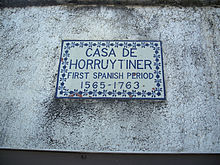
In 1821, after Mexico's War of Independence from Spain, Texas was part of the United Mexican States as the state of Coahuila y Tejas. A large influx of Americans soon followed, originally with the approval of Mexico's president. In 1836, the now largely "American" Texans, fought a war of independence from the central government of Mexico and established the Republic of Texas. In 1846, the Republic dissolved when Texas entered the United States of America as a state. Per the 1850 U.S. census, fewer than 16,000 Texans were of Mexican descent, and nearly all were Spanish-speaking people (both Mexicans and non-Spanish European settlers who include German Texan) who were outnumbered (six-to-one) by English-speaking settlers (both Americans and other immigrant Europeans).
After the Mexican War of Independence from Spain also, California, Nevada, Arizona, Utah, western Colorado and southwestern Wyoming became part of the Mexican territory of Alta California and most of New Mexico, western Texas, southern Colorado, southwestern Kansas, and Oklahoma panhandle were part of the territory of Santa Fe de Nuevo México. The geographical isolation and unique political history of this territory led to New Mexican Spanish differing notably from both Spanish spoken in other parts of the United States of America and Spanish spoken in the present-day United Mexican States.
Mexico lost almost half of the northern territory gained from Spain in 1821 to the United States in the Mexican–American War (1846–1848). This included parts of contemporary Texas, and Colorado, Arizona, New Mexico, and Wyoming, California, Nevada, and Utah. Although the lost territory was sparsely populated, the thousands of Spanish-speaking Mexicans subsequently became U.S. citizens. The war-ending Treaty of Guadalupe Hidalgo (1848) does not explicitly address language.
Through the force of sheer numbers, the English-speaking American settlers entering the Southwest established their language, culture, and law as dominant, to the extent it fully displaced Spanish in the public sphere; this is why the United States never developed bilingualism as Canada did. For example, the California constitutional convention of 1849 had eight Californio participants; the resulting state constitution was produced in English and Spanish, and it contained a clause requiring all published laws and regulations to be published in both languages. The constitutional convention of 1872 had no Spanish-speaking participants; the convention's English-speaking participants felt that the state's remaining minority of Spanish-speakers should simply learn English; and the convention ultimately voted 46-39 to revise the earlier clause so that all official proceedings would henceforth be published only in English.
Spanish–American War (1898)
Further information: Spanish–American WarIn 1898, consequent to the Spanish–American War, the United States took control of Cuba and Puerto Rico, Philippines and Guam as American territories. In 1902, Cuba became independent from the United States, while Puerto Rico remained a U.S. territory. Spanish is Puerto Rico's first language, and its citizens hold statutory U.S. citizenship.
For decades, the U.S. federal government strenuously tried to force Puerto Ricans to adopt English, to the extent of making them use English as the primary language of instruction in their high schools. It was completely unsuccessful, and retreated from that policy in 1948. Puerto Rico was able to maintain its Spanish language, culture, and identity because the relatively small, densely populated island was already home to nearly a million people at the time of the U.S. takeover, all of those spoke Spanish, and the territory was never hit with a massive influx of millions of English speakers like the vast territory acquired from Mexico 50 years earlier.
This policy was more successful in the Philippines, where only about 20% of the population had Spanish as their first language, but those were disseminated along the islands. Eventually the migrations caused by World War II broke the surviving Spanish-speaking communities. The usage of Spanish among elders is still quite large, however.
Modern mass migration

The relatively recent but large influx of Spanish-speakers to the United States has increased the overall total of Spanish-speakers in the country. They form majorities and large minorities in many political districts, especially in California, Arizona, New Mexico, and Texas, the American states bordering Mexico, and also in South Florida.
Mexicans first moved to United States as refugees in the turmoil of Mexican Revolution from 1910–1917, but many more emigrated later for economic reasons. The large majority of Mexicans are in the former Mexican-controlled areas in Southwest.
At over 5 million, Puerto Ricans are easily the 2nd largest Hispanic group. Of all major Hispanic groups, Puerto Ricans are the least likely to be proficient in Spanish, but millions of Puerto Rican Americans living in the U.S. mainland nonetheless are fluent in Spanish. Puerto Ricans are natural-born U.S. citizens, and many Puerto Ricans have migrated to New York City, Orlando, Philadelphia, and other areas of the Eastern United States, increasing the Spanish-speaking populations and in some areas being the majority of the Hispanophone population, especially in Central Florida. In Hawaii, where Puerto Rican farm laborers and Mexican ranchers have settled since the late 19th century, 7.0 per cent of the islands' people are either Hispanic or Hispanophone or both.
Immigration to the United States of Spanish-speaking Cubans began because of Cuba's political instability upon achieving independence. The deposition of Fulgencio Batista's dictatorship and the ascension of Fidel Castro's government in 1959 increased Cuban immigration to the United States, hence there are some one million Cubans in the United States, most settled in southern and central Florida, while other Cubans live in the Northeastern United States; most are fluent in Spanish. In the city of Miami today Spanish is the first language mostly due to Cuban immigration.
Likewise the migration of Spanish-speaking Nicaraguans also began as a result of political instability during the end of the 1970s and the 1980s. The uprising of the Sandinista revolution which toppled the Somoza dictatorship in 1979 caused many Nicaraguans to migrate particularly from those opposing the Sandinistas. Throughout the 1980s with the United States supported Contra War (or Contra-revolutionary war) which continued up until 1988, and the economic collapse of the country many more Nicaraguans migrated to the United States amongst other countries. The states of the United States where most Nicaraguans migrated to include Florida, California and Texas.

The exodus of Salvadorans was a result of both economic and political problems. The largest immigration wave occurred as a result of the Salvadoran Civil War in the 1980s, in which 20–30% of El Salvador's population emigrated. About 50%, or up to 500,000 of those who escaped headed to the United States, which was already home to over 10,000 Salvadorans, making Salvadorans Americans the fourth-largest Hispanic and Latino American group, after the Mexican-American majority, stateside Puerto Ricans, and Cubans.
As civil wars engulfed several Central American countries in the 1980s, hundreds of thousands of Salvadorans fled their country and came to the United States. Between 1980 and 1990, the Salvadoran immigrant population in the United States increased nearly fivefold from 94,000 to 465,000. The number of Salvadoran immigrants in the United States continued to grow in the 1990s and 2000s as a result of family reunification and new arrivals fleeing a series of natural disasters that hit El Salvador, including earthquakes and hurricanes. By 2008, there were about 1.1 million Salvadoran immigrants in the United States.
Until the 20th century, there was no clear record of the number of Venezuelans who emigrated to the United States. Between the 18th and early 19th centuries, there were many European immigrants who went to Venezuela, only to later migrate to the United States along with their children and grandchildren who born and/or grew up in Venezuela speaking Spanish. From 1910 to 1930, it is estimated that over 4,000 South Americans each year emigrated to the United States; however, there are few specific figures indicating these statistics. Many Venezuelans settled in the United States with hopes of receiving a better education, only to remain in there following graduation. They are frequently joined by relatives. However, since the early 1980s, the reasons for Venezuelan emigration have changed to include hopes of earning a higher salary and due to the economic fluctuations in Venezuela which also promoted an important migration of Venezuelan professionals to the US.
In the 2000s, more Venezuelans opposing the economic and political policies of president Hugo Chávez migrated to the United States (mostly to Florida, but New York City and Houston are other destinations). The largest concentration of Venezuelans in the United States is in South Florida, especially the suburbs of Doral and Weston. Other main states with Venezuelan American populations are, according to the 1990 census, New York, California, Texas (adding their existing Hispanic populations), New Jersey, Massachusetts and Maryland. Some of the urban areas with a high Venezuelan community include Miami, New York City, Los Angeles, and Washington, D.C.
Migration of refugees from Spain began also because of civil war between 1936 & 1939 and political instability under the regime of Francisco Franco that lasted to 1975. The majority of Spaniards settled Florida, Texas, California, New Jersey, New York City, Chicago, and Puerto Rico.
Geographic distribution
See also: Languages of the United States and List of U.S. cities by Spanish-speaking populationIn total, there were 36,995,602 people aged five or older in the United States who spoke Spanish at home (12.8% of the total U.S. population). Over half of the country's Spanish-speakers reside in California, Texas, and Florida.
American Spanish-speakers
| Year | Number of native Spanish-speakers | Percent of US population |
|---|---|---|
| 1980 | 11 million | 5% |
| 1990 | 17.3 million | 7% |
| 2000 | 28.1 million | 10% |
| 2010 | 37 million | 13% |
| 2015 | 41 million | 13% |
| Sources: | ||
Current status

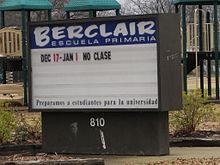

Although the United States has no de jure official language, English is the dominant language of business, education, government, religion, media, culture, civil society, and the public sphere. Virtually all state and federal government agencies and large corporations use English as their internal working language, especially at the management level. Some states, such as New Mexico, provide bilingual legislated notices and official documents, in Spanish and English, and other commonly used languages. By 2015, there was a trend that most Americans and American residents who are of Hispanic descent speak only English in the home.
As noted above, the only major exception is the U.S. Commonwealth of Puerto Rico, where Spanish is the official and most commonly used language.
Throughout the history of the Southwest United States, the controversial issues of language as part of cultural rights and bilingual state government representation has caused socio-cultural friction between Anglophones and Hispanophones. Currently, Spanish is the most widely taught second language in the United States.
California
California's first constitution recognized Spanish language rights:
All laws, decrees, regulations, and provisions emanating from any of the three supreme powers of this State, which from their nature require publication, shall be published in English and Spanish.
— California Constitution, 1849, Art. 11 Sec. 21.
By 1870, English-speaking Americans were a majority in California; in 1879, the state promulgated a new constitution under which all official proceedings were to be conducted exclusively in English, a clause that remained in effect until 1966. In 1986, California voters added a new constitutional clause, by referendum, stating that:
English is the official language of the State of California.
— California Constitution, Art. 3, Sec. 6
Spanish remains widely spoken throughout the state, and many government forms, documents, and services are bilingual, in English and Spanish. And although all official proceedings are to be conducted in English:
A person unable to understand English who is charged with a crime has a right to an interpreter throughout the proceedings.
— California Constitution, Art. 1. Sec. 14
Arizona
The state (like its southwestern neighbors) has had close linguistic and cultural ties with Mexico. The state outside the Gadsden Purchase of 1853 was part of the New Mexico Territory until 1863, when the western half was made into the Arizona Territory. The area of the former Gadsden Purchase contained a majority of Spanish-speakers until the 1940s, although the Tucson area had a higher ratio of anglophones (including Mexican Americans who were fluent in English); the continuous arrival of Mexican settlers increases the number of Spanish-speakers.
New Mexico
Main article: New Mexican SpanishNew Mexico is commonly thought to have Spanish as an official language alongside English because of its wide usage and legal promotion of Spanish in the state; however, the state has no official language. New Mexico's laws are promulgated bilingually in Spanish and English. Although English is the state government's paper working language, government business is often conducted in Spanish, particularly at the local level. Spanish has been spoken in the New Mexico-Colorado border and the contemporary U.S.–Mexico border since the 16th century.
Because of its relative isolation from other Spanish-speaking areas over most of its 400-year existence, New Mexico Spanish, and in particular the Spanish of northern New Mexico and Colorado has retained many elements of 16th- and 17th-century Spanish and has developed its own vocabulary. In addition, it contains many words from Nahuatl, the language spoken by the ancient Aztecs of Mexico. New Mexican Spanish also contains loan words from the Pueblo languages of the upper Rio Grande Valley, Mexican-Spanish words (mexicanismos), and borrowings from English. Grammatical changes include the loss of the second person verb form, changes in verb endings, particularly in the preterite, and partial merging of the second and third conjugations.
Texas
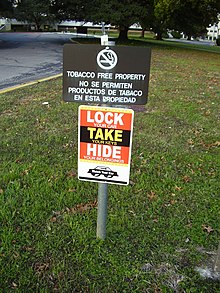
| This section needs additional citations for verification. Please help improve this article by adding citations to reliable sources in this section. Unsourced material may be challenged and removed. (June 2010) (Learn how and when to remove this message) |
In Texas, English is the state's de facto official language (though it lacks de jure status) and is used in government. However, the continual influx of Spanish-speaking immigrants increased the import of Spanish in Texas. Although its a part of the Southern United States, Texas's counties bordering Mexico are mostly Hispanic, and consequently, Spanish is commonly spoken in the region. The Government of Texas, through Section 2054.116 of the Government Code, mandates that state agencies provide information on their websites in Spanish to assist residents who have limited English proficiency.
Puerto Rico
Main article: Puerto Rican SpanishThe Commonwealth of Puerto Rico recognizes Spanish and English as official languages; Spanish is the dominant first language.
Spanish place names
Main article: List of U.S. place names of Spanish originLearning trends in the United States
Spanish is currently the most widely taught non-English language in American secondary schools and of higher education. More than 1.4 million university students were enrolled in language courses in autumn of 2002 and Spanish is the most widely taught language in American colleges and universities with 53 percent of the total number of people enrolled, followed by French (14.4%), German (7.1%), Italian (4.5%), American Sign language (4.3%), Japanese (3.7%), and Chinese (2.4%) although the totals remain relatively small in relation to the total U.S population.
Variation
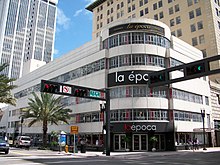
The influence of English on American Spanish is very important. In many Latino (also called Hispanic) youth subcultures, it is fashionable to variously mix Spanish and English, thereby producing Spanglish. Spanglish is the name for the admixture of English words and phrases to Spanish for effective communication.
The new generation of American Hispanics want to preserve knowing and using Spanish as equal to learning and using English. The Academia Norteamericana de la Lengua Española (North American Academy of the Spanish Language) tracks the developments of the Spanish spoken in the United States, and the influences of English upon it.
Spanish sub-types
Language experts distinguish the following varieties of the Spanish spoken in the United States:
- Mexican: the U.S.–Mexico border, throughout the US southwest from California to Texas, as well as the city of Chicago, but becoming ubiquitous throughout the continental United States as Mexican Spanish is used as the standardized dialect of Spanish in the continental United States
- Caribbean Spanish: Spanish as spoken by Puerto Ricans, Cubans, and Dominicans. Largely heard throughout the Northeastern United States and Florida, especially New York City and Miami, among other cities in the Eastern US
- Central American Spanish: Spanish as spoken by Hispanics with origins in Central American countries such as El Salvador, Guatemala, Honduras, Nicaragua, Costa Rica, and Panama. Largely heard in major cities throughout California and Texas, as well as Washington DC, New York, and Miami.
- Colonial Spanish: Spanish as spoken by descendants of Spaniard colonists and early Mexicans before United States expansion and annextion of the US southwest and other areas.
- Californian (1769–present): California, especially the Central Coast
- Isleño (Islander) (18th century–present): St. Bernard Parish, Louisiana
- New Mexican Spanish: Central and north-central New Mexico and south-central Colorado and the border regions of Arizona, Texas, and New Mexico, and southeastern Colorado
Most post-first generations of Spanish-speakers tend to speak the language with American English accents of the region they grew up in.
Common English words derived from Spanish
Main article: List of English words of Spanish originAnalogously, many Spanish words now are standard American English.
- Admiral
- Avocado (aguacate from Nahuatl aguacatl)
- Aficionado
- Banana (originally from Wolof)
- Buckaroo (vaquero)
- Cafeteria (cafetería)
- Chocolate (from Nahuatl xocolatl)
- Cigar (cigarro)
- Corral
- Coyote ("Coyote" from Nahuatl "Coyotl")
- Desperado (desesperado)
- Guerrilla
- Guitar (guitarra)
- Hurricane (huracán)
- Junta
- Lasso ("lazo")
- Potato ("patata", see Eytmology of "potato" for more details)
- Ranch ("Rancho")
- Rodeo
- Siesta
- Tomato ("Tomate" from Nahuatl "Tomatl")
- Tornado
- Vanilla (vainilla')
Phonetic features
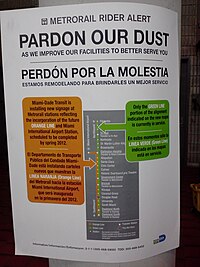
- As most of ancestors of Hispanic Americans came from Hispanic America, ⟨z⟩ and ⟨c⟩ (before /e/ and /i/) are pronounced as [s], the same as ⟨s⟩. However, seseo (replacement of [θ] with [s]) is also typical on the speech of Hispanic Americans of Andalusian and Canarian descent. Andalusia's and the Canary Island's predominant position in the conquest and subsequent immigration to Hispanic America from Spain is thought to be the reason for the absence of this distinction in most Hispanic American dialects. Most Americans of Spanish descent pronounce the two letters as [θ].
- Most of Spain, particularly the regions that have a distinctive /θ/ phoneme, realize /s/ with the tip of tongue against the alveolar ridge. Phonetically this is an "apico-alveolar" "grave" sibilant [s̺], with a weak "hushing" sound reminiscent of retroflex fricatives. To a Hispanic and Latino American speaker, European Spanish /s/ is close to [ʃ] like English sh as in she. However, this apico-alveolar realization of /s/ is not uncommon in some Latin American Spanish dialects which lack [θ]; some inland Colombian Spanish (particularly Antioquia) and Andean regions of Peru and Bolivia also have an apico-alveolar /s/.
- Spanish in the United States usually features yeísmo: there is no distinction between ⟨ll⟩ and ⟨y⟩, and both are [ʝ]. However, yeísmo is an expanding and now dominant feature of European Spanish, particularly in urban speech (Madrid, Toledo) and especially in Andalusia and Canary Islands, though in rural use [ʎ] is preserved not only in central and northern Spain but also in scatter areas of Andalusia and the Canary Islands. Speakers of Rioplatense Spanish pronounce both ⟨ll⟩ and ⟨y⟩ as [ʒ] or [ʃ]. The traditional pronunciation of the digraph ⟨ll⟩ as [ʎ] is preserved in some dialects along the Andes range, especially in inland Peru and the Colombia highlands (Santander), northern Argentina, all Bolivia and Paraguay.
- Most speakers with ancestors born in coastal dialects may debuccalize or aspirate syllable-final /s/ to [h], or drop it entirely, so that está Template:IPA-es ("s/he is") sounds like or , as in southern Spain (Andalusia, Murcia, Castile–La Mancha (except North-East), Canary Islands, Ceuta and Melilla).
- ⟨g⟩ (before /e/ or /i/) and ⟨j⟩ are usually aspirated to [h] in Caribbean and other coastal language vernaculars, as well as in all Colombia, and southern Mexico, as in most southern Spanish speeches. While it may be [x] in other dialects of Hispanic Americans and often firmly strong (rough) in Peruvian Spanish dialect, this is a common feature of Castilian Spanish. it is usually aspirated to [h] as in most southwestern Spanish varieties. Very often, especially in Argentina and Chile, [x] becomes fronter [ç] when preceding high vowels /e, i/ (these speakers approach [x] to the realization of German ⟨ch⟩ in ich); in other phonological environments it is pronounced either [x] or [h].
- In many Caribbean speeches the phonemes /l/ and /r/ at the end of a syllable sound alike or can be exchanged: caldo > cado, cardo > cado, in the situation of /r/ in word-final position, it becomes silent, giving Caribbean dialects of Spanish a partial non-rhoticity. This happens at a reduced level in Ecuador and Chile as well and is a feature brought from Extremadura and westernmost Andalusia.
- In many Andean regions the alveolar trill of rata and carro is realized as an alveolar approximant [ɹ] or even as a voiced apico-alveolar [z]. The alveolar approximant realization is particularly associated with an indigenous substrate and it is quite common in Andean regions, especially in inland Ecuador, Peru, most of Bolivia and in parts of northern Argentina and Paraguay.
- In Puerto Rico, aside from [ɾ], [r], and [l], syllable-final /r/ can be realized as [ɹ], an influence of American English to Puerto Rican dialect; "verso"' (verse) becomes , aside from , , or , "invierno" (winter) becomes , aside from , , or , and "escarlata" (scarlet) becomes , aside from , , or . In word-final position, /r/ will usually be one of these:
- The voiced consonants /b/, /d/, and /ɡ/ are pronounced as plosives after and sometimes before any consonant in most of Colombian Spanish dialects (rather than the fricative or approximant that is characteristic of most other dialects): pardo , barba , algo , peligro , desde —rather than the , , , , of Spain and the rest of Spanish America. A notable exception is the Department of Nariño and most Costeño speech (Atlantic coastal dialects) which feature the soft, fricative realizations common to all other Hispanic American and European dialects.
- Word-final /n/ is velar [ŋ] in much Latin American Spanish speech; this means a word like pan (bread) is often articulated . To an English-speaker, those speakers that have a velar nasal for word-final /n/ make pan sound like pang. Velarization of word-final /n/ is so widespread in the Americas that it is easier to mention those regions that maintain an alveolar, Castilian-style, /n/: most of Mexico, Colombia (except for coastal dialects) and Argentina (except for some northern regions). Elsewhere, velarization is common, though alveolar word-final /n/ can appear among some educated speakers, especially in the media or in singing. Velar word-final /n/ is also frequent in Spain, especially in southern Spanish dialects (Andalusia and the Canary Islands) and also in the Northwest: Galicia, Asturias and León.
Lexical features
- Anglicisms are far more common among Hispanic and Latino Americans (as is with Hispanic America) than in Spain, due to the stronger and more direct US influence in Hispanic America.
- Equally, indigenous languages have left their mark on American Spanish, particularly evident in vocabulary concerning flora, fauna and cultural habits.
- Disappearance of de (of) in certain expressions, as is the case with the dialect of Spanish in Canary Islands. Example: esposo Rosa instead of esposo de Rosa, gofio millo instead of gofio de millo, etc.
- Doublets of Arabic-Latinate synonyms with the Arabic form are more common in American Spanish, which derives from Latin American Spanish and so influenced by Andalusian Spanish like Andalusian and Latin American alcoba for standard habitación or dormitorio ('bedroom') or alhaja for standard joya ('jewel').
- See List of words having different meanings in Spain and Hispanic America.
Future of Spanish in the United States
| This section does not cite any sources. Please help improve this section by adding citations to reliable sources. Unsourced material may be challenged and removed. (January 2013) (Learn how and when to remove this message) |
Spanish-speaking Americans are the fastest growing linguistic group in the United States. Continual immigration and prevalent Spanish-language mass media (such as Univisión, Telemundo, and Azteca América) support the Spanish-speaking populations. Moreover, because of the North American Free Trade Agreement, it is common for many American manufacturers to use multilingual product labeling using English, French and Spanish.
Besides the businesses that always have catered to Hispanophone immigrants, a small, but increasing, number of mainstream American retailers now advertise bilingually in Spanish-speaking areas and offer bilingual, English-Spanish customer services. One common indicator of such businesses is Se Habla Español which means "Spanish Is Spoken".
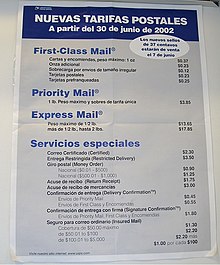
The State of the Union Addresses and other presidential speeches are translated to Spanish, following the precedent set by the Bill Clinton administration. Official Spanish translations are available at WhiteHouse.gov. Moreover, non-Hispanic American origin politicians fluent in Spanish-speak in Spanish to Hispanic majority constituencies. There are 500 Spanish newspapers, 152 magazines, and 205 publishers in the United States; magazine and local television advertising expenditures for the Hispanic market have increased much from 1999 to 2003, with growth of 58 percent and 43 percent, respectively.
Historically, immigrants' languages tend to disappear or become reduced through generational assimilation. Spanish disappeared in several countries and U.S. territories during the 20th century, notably in the Philippines and in Pacific Island countries of Guam, Micronesia, Palau, the Northern Marianas islands, and the Marshall Islands.
The English-only movement seeks to establish English as the sole official language of the United States. Generally, they exert political public pressure upon Hispanophone immigrants to learn English and speak it publicly; as universities, business, and the professions use English, there is much social pressure to learn English for upward socio-economic mobility.
Generally, Hispanic American origin US residents (13.4% of the 2002 population) are bilingual to a degree. A Simmons Market Research survey recorded that 19 percent of the Hispanic American origin population speak only Spanish, 9.0 percent speak only English, 55 percent have limited English proficiency, and 17 percent are fully English-Spanish bilingual.
Intergenerational transmission of Spanish is a more accurate indicator of Spanish's future in the United States than raw statistical numbers of Hispanophone immigrants. Although Hispanic American origin immigrants hold varying English proficiency levels, almost all second-generation Hispanic American origin US residents speak English, yet about 50 percent speak Spanish at home. Two-thirds of third-generation Mexican Americans speak only English at home.
Calvin Veltman undertook, for the National Center for Education Statistics and for the Hispanic Policy Development Project, the most complete study of English language adoption by Hispanophone immigrants. Mr Veltman's language shift studies document high bilingualism rates and subsequent adoption of English as the preferred language of Hispanics, particularly by the young and the native-born. The complete set of these studies' demographic projections postulates the near-complete assimilation of a given Hispanophone immigrant cohort within two generations. Although his study based itself upon a large 1976 sample from the Bureau of the Census (which has not been repeated), data from the 1990 Census tend to confirm the great Anglicization of the US Hispanic American origin population.
American literature in Spanish
Southwest Colonial literature
In 1610, Gaspar Pérez de Villagrá published his Historia de Nuevo México (History of New Mexico).
19th century
In 1880, José Martí moved to New York City.
Eusebio Chacón published El hijo de la tempestad in 1892.
20th century
Federico García Lorca wrote his collection of poems, Poeta en Nueva York, and the two plays Así que pasen cinco años and El público while living in New York. Giannina Braschi wrote the Hispanic postmodern poetry classic El imperio de los sueños in Spanish in New York. José Vasconcelos and Juan Ramón Jiménez were both exiled to the United States.
In her autobiography When I was Puerto Rican (1993), Esmeralda Santiago recounts her childhood on the island during the 1950s and her family's subsequent move to New York City, when she was 13 years old. Originally written in English, the book is an example of New York Rican literature.
See also
- List of most commonly learned foreign languages in the United States
- List of U.S. cities with diacritics
- List of U.S. communities with Hispanic majority populations
- List of Spanish-language newspapers published in the United States
International comparisons:
General:
- Bilingual education
- Spanish language in the Americas
- List of colloquial expressions in Honduras
- Spanish language in the Philippines
- History of the Spanish language
- Languages in the United States
References
- Instituto Cervantes (Enciclopedia del español en Estados Unidos)
- Instituto Cervantes' Yearbook 2006–07. (PDF) . Retrieved on 2011-12-31.
- "Más 'speak spanish' que en España". Retrieved October 6, 2007.
- "2000 Census, Language in the US" (PDF). Retrieved June 5, 2007.
- "Primary language spoken at home by people aged 5 or older". United States Census Bureau. Retrieved 2012.
{{cite web}}: Check date values in:|accessdate=(help) - US Census Bureau Public Information Office. "Facts for Features: Hispanic Heritage Month 2010: Sept. 15 — Oct. 15 - Facts for Features & Special Editions - Newsroom - U.S. Census Bureau". Retrieved 5 March 2015.
- Van Young, Eric (2001). The Other Rebellion: Popular Violence, Ideology, and the Mexican Struggle. Stanford University Press. p. 324. ISBN 978-0-8047-4821-6.
- Guadalupe Valdés et al., Developing Minority Language Resources: The Case of Spanish in California (Clevedon, UK: Multilingual Matters, 2006), 28–29.
- ^ Drew Walker (2010). "A Countries and Their Cultures: Venezuelan American". Countries and their cultures. Retrieved December 10, 2011.
- "Primary language spoken at home by people aged 5 or older". United States Census Bureau. Retrieved 2010.
{{cite web}}: Check date values in:|accessdate=(help) - "What is the future of Spanish in the United States?". Pew Research Center. 5 September 2013. Retrieved 5 March 2015.
- http://www.census.gov/prod/2003pubs/c2kbr-29.pdf
- "The Future of Spanish in the United States". Retrieved 5 March 2015.
- Data Access and Dissemination Systems (DADS). "American FactFinder - Results". Retrieved 5 March 2015.
- Nasser, Haya El (January 2, 2015). "Candidates Facing More Latino Voters Who Don't Speak Spanish". Al Jazeera.
- Enrollments in Languages Other Than English in United States Institutions of Higher Education, Fall 2009.
- ^ Cobos, Rubén (2003) "Introduction" A Dictionary of New Mexico & Southern Colorado Spanish (2nd ed.) Museum of New Mexico Press, Santa Fe, N.M., p. ix, ISBN 0-89013-452-9
- Cobos, Rubén, op. cit., pp. x-xi.
- Cite error: The named reference
CensusBureauwas invoked but never defined (see the help page). - "Sec. 2054.001." Texas Legislature. Retrieved on June 27, 2010.
- Richard I. Brod Archived 2001-11-25 at the Wayback Machine. AFL Bulletin. Vol. 19, no. 2 (January 1988): 39–44
- Languages Spoken and Learned in the United States. Vistawide.com. Retrieved on 2011-12-31.
- Most Studied Foreign Languages in the U.S. —. Infoplease.com. Retrieved on 2011-12-31.
- Jordan, Miriam (April 4, 2012). "'Hispanics' Like Clout, Not the Label". The Wall Street Journal.
- D.M. Levine (2012-01-19). "As Hispanic Television Market Grows, Univision Reshuffles Executives". Adweek. Retrieved 2013-10-02.
External links
| Dialects and varieties of Spanish by continent | |||||||||
|---|---|---|---|---|---|---|---|---|---|
| Africa and Asia | |||||||||
| Americas (Interamerican) |
| ||||||||
| Europe (Peninsular) |
| ||||||||
| Other |
| ||||||||
| Extinct | |||||||||
| United States articles | |||||||||||||||||||||||||||||||||||||||
|---|---|---|---|---|---|---|---|---|---|---|---|---|---|---|---|---|---|---|---|---|---|---|---|---|---|---|---|---|---|---|---|---|---|---|---|---|---|---|---|
| History |
| ||||||||||||||||||||||||||||||||||||||
| Geography | |||||||||||||||||||||||||||||||||||||||
| Politics |
| ||||||||||||||||||||||||||||||||||||||
| Economy |
| ||||||||||||||||||||||||||||||||||||||
| Society |
| ||||||||||||||||||||||||||||||||||||||
| United States state-related lists | |
|---|---|
| List of states and territories of the United States | |
| Demographics | |
| Economy |
|
| Environment | |
| Geography | |
| Government |
|
| Health | |
| History | |
| Law |
|
| Miscellaneous | |